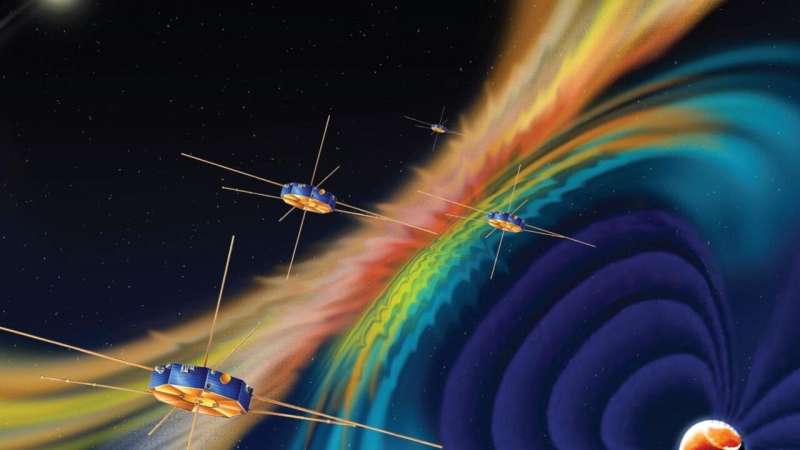This article has been reviewed according to Science X's editorial process and policies. Editors have highlighted the following attributes while ensuring the content's credibility:
fact-checked
peer-reviewed publication
trusted source
proofread
Novel algorithm improves understanding of plasma shock waves in space

Imagine the explosive disturbance caused by a jet going supersonic. A similar shock wave occurs when subatomic particles known as "solar wind" flow from the sun and strike the Earth's magnetic field. Now, scientists have used a recently developed technique to improve predictions of the timing and intensity of the solar wind's strikes, which sometimes disrupt telecommunications satellites and damage electrical grids.
The research team—led by James Juno, a staff physicist at the U.S. Department of Energy's (DOE) Princeton Plasma Physics Laboratory (PPPL)—used what is known as "field-particle correlation" (FPC) for a detailed view of how shock waves composed of plasma, the hot, charged state of matter that makes up 99% of the visible universe, can heat up blobs of plasma in outer space.
FPC is an algorithm that digests data produced by spacecraft or computers and determines how the energy of magnetic fields and moving plasma particles change back and forth. The process gives precise information about the particles' positions and velocities as the changes occur.
"Though much of what we found was already well known, heat transfer has never been examined in this way before," said James Juno, a staff physicist at the U.S. Department of Energy's (DOE) Princeton Plasma Physics Laboratory (PPPL) and lead author of a paper reporting the results in The Astrophysical Journal. "The fact that this technique works as well as it does shows us that there are new ways to look at old problems."
PPPL scientists study plasma because it fuels fusion reactions within doughnut-shaped devices known as tokamaks and twisty facilities known as stellarators. Plasma is a soup of atomic nuclei, or ions, electrons, and neutral atoms that together allow the flow of electric current. That flow allows plasma to respond to magnetic fields, which scientists use to corral the plasma within fusion facilities. Researchers are trying to harness fusion, which drives the sun and stars, to generate electricity without producing greenhouse gases and long-lived radioactive waste.
The FPC technique reveals plasma behavior never observed before, including which parts of the plasma are heating up and which physical processes are responsible. Older techniques can produce only broad pictures of where and how a plasma heats up.
"One of our key findings is that different regions of the plasma could respond to a shock wave in different ways," Juno said. "We now have a more holistic picture of what's going on in the shock wave interactions."
"This means that we can discover the energy of a specific particle at a particular position and that a shock wave is transferring energy to a particular plasma region," Juno said. "Previous methods cannot distinguish between the large variety of processes that are occurring."
Juno and colleagues performed the FPC technique, which was developed by Gregory Howes at the University of Iowa, on data produced by a plasma simulation program known as Gkeyll (pronounced like Robert Louis Stevenson's Dr. "Jekyll"). PPPL developed the code to simulate the orbiting of plasma particles around magnetic field lines at the edge of the plasma in tokamak fusion facilities. Scientists are constantly updating the program to extend its capabilities.
"Gkeyll has many components that apply to a range of plasma problems, from space plasmas to laboratory fusion experiments," said Ammar Hakim, PPPL deputy associate laboratory director for the computational sciences department. "And with new National Science Foundation investment in the Cyberinfrastructure for Sustained Science Innovation program, we are improving Gkeyll to make it a national resource for plasma simulations."
Scientists can use FPC to glean information from current space voyages like NASA's Magnetospheric Multiscale (MMS) mission, which employs four satellites flying in formation in the region of space affected by Earth's magnetic field. "The MMS mission presents an incredible opportunity to study space plasmas using the FPC technique," says Collin Brown, researcher at the University of Iowa and co-author of the paper. "That significantly enhances our ability to study the three-dimensional structure of energy transfer."
Moreover, "it's one thing to use a supercomputer to reproduce a plasma shock wave," Juno said. "But the FPC technique can actually help you learn new things about the world. And that's exciting."
More information: James Juno et al, Phase-space Energization of Ions in Oblique Shocks, The Astrophysical Journal (2023). DOI: 10.3847/1538-4357/acaf53
Journal information: Astrophysical Journal
Provided by Princeton Plasma Physics Laboratory





















